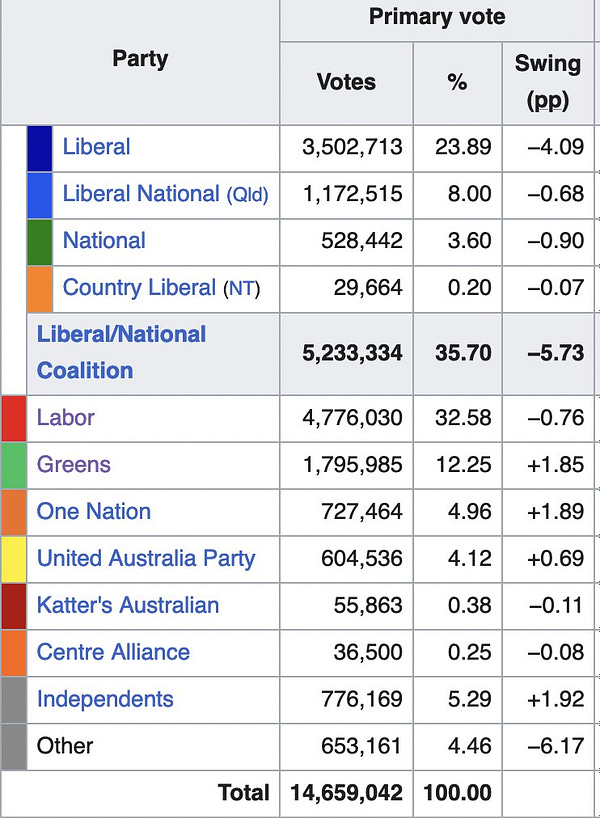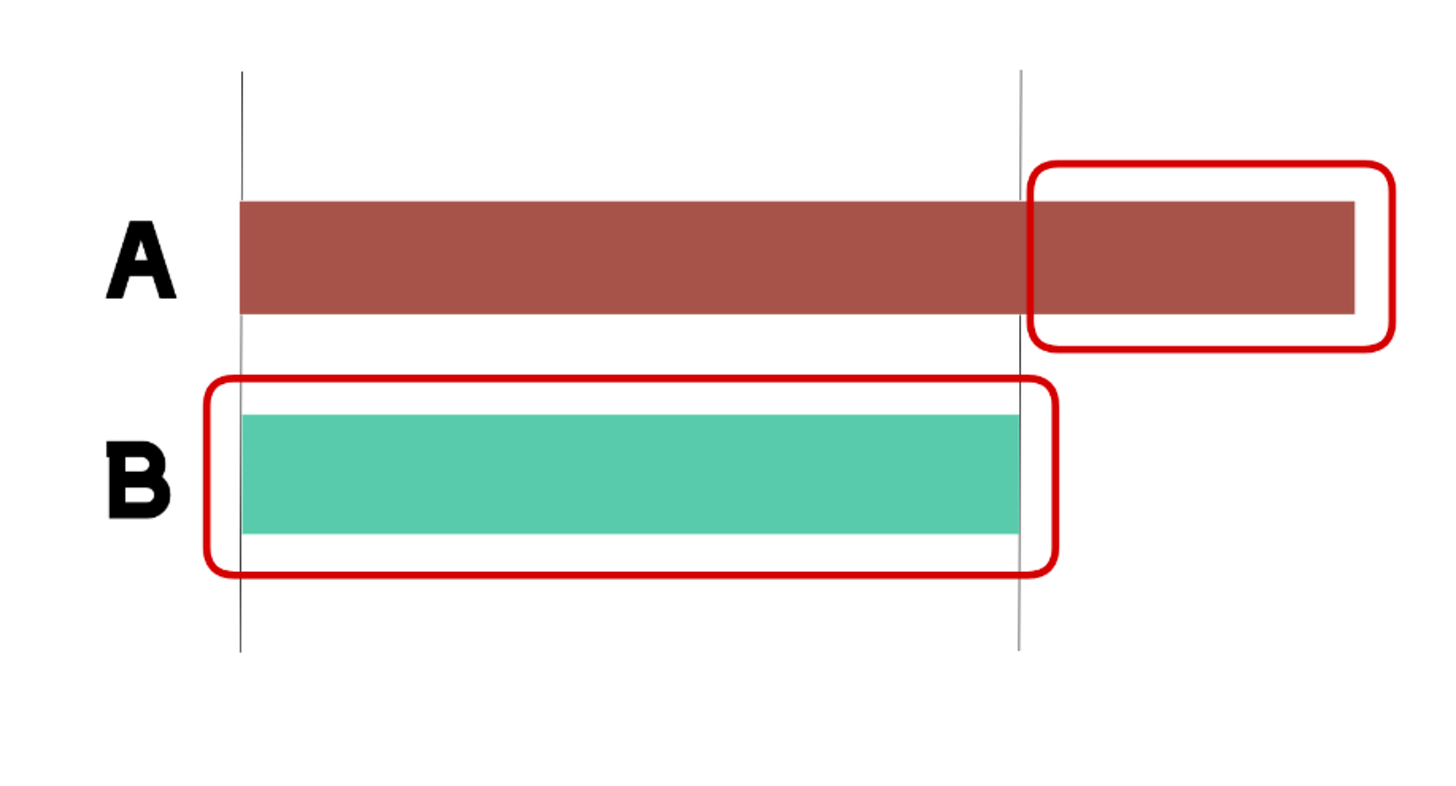A couple of days ago, my tweet on proportionality in Australia’s lower house made a lot of people very mad:


Although I worded this tweet a little provocatively, I was making a serious point: Lack of proportionality results in unfair outcomes. This affects minor parties most (The Greens got 12% of the vote and 2.6% of the seats, One Nation got 5% of the vote and 0% of the seats) but major parties too (Labor won more than half the seats while receiving fewer total votes than the LNP bloc).
Why does this make people so mad?
While a lot of people understood the point of the post (mostly those who support proportional representation), a ton of people didn’t. While many were just drive-by nitpickers and pedants (who assumed I was completely unaware of preferential voting), a lot of people, including many people generally regarded as election experts, such as Antony Green, Kevin Bonham, and Ben Raue, seemed to miss the point of the post, and, in particular, objected to the use of the word “gerrymandering”.
So I thought I’d write this longer form piece as an explainer on the issue.
Understanding the problems that preferential voting doesn’t fix
One challenge with this issue is that many Australians are under the belief that preferential voting is already the best possible voting system. As Eleanor Robertson notes:

It’s certainly true that preferential voting is better than many other systems. “First past the post” voting, as used in the US and UK, is terrible.
Any vote for a candidate that isn’t a frontrunner is risky, and likely wasted. Preferential voting reduces that problem. The preferencing process converts every race into a head-to-head contest in which every vote participates.
While, again, this is an improvement over First Past the Post, multiple problems remain:
Because each division is represented by a single member, it’s winner-takes-all. Once the outcome has been determined, some votes remain in the losing pile of the head-to-head contest. Those votes receive zero representation. All the representation (1 seat) is awarded to the winning pile.
Winner-takes-all also means that winning margin doesn’t matter. Win by 1 vote, or win by 10000, the result is the same: 1 representative. These votes (all votes beyond a margin of 1) also receive no representation.
Political parties understand these realities well - it’s why they don’t bother campaigning in safe seats. Convincing an extra 1000 people to vote Party A in a safe Party A seat is a waste of time, as is convincing 1000 people to vote Party A in a safe Party B seat if it still results in a loss.
Election experts have a term for such votes: Wasted vote.
For each head-to-head race (remember, preferential voting converts each seat’s votes into a single head-to-head race involving all valid votes), the wasted vote can be visualized as follows:
All the excess winning votes for Party A, and all the losing votes for Party B, are wasted.
This is almost always more than half the total votes! In most Federal elections, it’s around 60%.
Even with preferential voting, more than half of all votes are wasted and are awarded zero representation!
Another way to think of this, is that preferential voting prevents votes from ending up wasted in 3rd place or worse, but not in 2nd place or 1st place.
The problems don’t end there. Even if your votes still counts through preferences, your first preference still doesn’t get elected. Suppose you preference parties A, B, C and D, and party C gets elected thanks to your vote. While you helped get more representation for C instead of D (which you hate!), your favourite party, A, still doesn’t get any. The optimal outcome, more representation for A, didn’t happen. Party C might be barely any better than Party D, in your eyes.
Minor party voters know this well. They probably chose a minor party out of dissatisfaction with a major party - but their vote ends up just going to back to the major party anyway.
I’m not aware of a specific term for such votes, but we might call them “partially wasted votes”.
Wasted vote is the cause of non-proportionality
It’s wasted vote (including partially wasted vote) that causes the outcome described in my tweet.
The Greens get less than 12% of the seats because a lot of their vote was (fully or partially) wasted. Labor gets a majority of seats from 32% of the vote because so much of their opponents’ vote was wasted. Remember: 60% of the votes in that table don’t flow to any representation.
Astute observers will note that while some parties lose out a lot from wasted vote (UAP and One Nation in particular), some parties benefit, like the Nationals and the Teal independents. More generally, wasted vote favours major parties.
Why do some benefit from wasted vote while others lose out? One key factor determines this: Geographic concentration.
Having your voters concentrated in a particular seat confers great advantage. Nationals win rural seats because their voters are concentrated heavily in those seats. Teals win wealthy middle-urban seats for the same reason. UAP and One Nation are geographically dispersed (after all, racists and idiots are everywhere) and so lose out.
(While we might detest those parties, one can’t claim to be committed to democratic and representative outcomes and support this denial of representation).
Stop to think about it, it seems bizarre. To win an election, what matters is not just how many votes you get, but where those voters are. Why should that matter in determining a national result?
There are no neutral electorate boundaries
It’s well known that the boundaries of Australia’s electoral divisions are chosen by a neutral party - the AEC, through a transparent process. This works well, and is obviously a good thing.
But the AEC choose electoral maps within the context of the country’s chosen electoral system.
Because geographic concentration (or dispersal) play such an overwhelming role of determining election outcomes, the very existence of these divisions plays a huge role in the outcome.
We think of a “neutral” map of evenly-populated, evenly-shaped areas as unbiased. But it’s anything but. Any such layout will inevitably produce demographic concentrations that favour certain parties.
Major parties benefit because these concentrations group enough of their voters together to make it a strong seat. And rural/well-off urban concentrations benefit the Nationals/teals as we just discussed.
That means these parties have a strong self-interest in opposing any political change that might get rid of these boundaries in favour of a neutral arrangement, such as larger multi-member electorates, or the one giant electorate of a purely proportional system.
Put another way: By resisting electoral change, these parties are engaged in the political manipulation of electoral district boundaries with the intent to create undue advantage. This is called gerrymandering.
Gerrymandering is the manipulation of wasted vote
When imagining a classic gerrymandering scenario, we think about a boundary being moved to include a town full of favourable voters, for example.
But why does this work?
What’s fundamentally going on here is the manipulation of wasted vote - the gerrymanderers in this scenario are trying to move their votes from being wasted votes in the neighbouring seat, to non-wasted winning votes within their own boundary.
In other words, they are trying to use wasted vote to their advantage, even if that might mean a less democratic result.
Considered from this perspective, it becomes much clearer that Australia’s house of representatives is gerrymandered itself.
The major parties are engaged in an ongoing project of wasted vote manipulation to maintain their electoral advantage.
Not only is it reasonable to describe this as gerrymandering, it’s a conceptual mistake to think otherwise.





So many things I disagree with here.
In simple terms preferential voting leads to the election of the least unpopular candidate (as opposed to the most popular), I think this is a good thing.
As for the neutrality of AEC, in name, yes, but in practice that’s questionable. I refer back to the late Peter Andren’s requests to the AEC for differing outline this then electorate of Calare.
Or even my current electorate in central west NSW that ridiculously goes all the way down to the very different Riverina
I may look again later.
You're generalising the term gerrymandering beyond its usual meaning. If I'm reading you correctly, endorsing (or not actively moving to) any system other than thresholdless PR is gerrymandering.
I have a few other quibbles:
1) gerrymandering implies an active manipulation of the boundaries by the political parties, yet I think you still need to show that it has happened.
2) There's a tradeoff in any kind of voting system. There's a tension between ensuring local community representation and proportionality. That is not inherently undemocratic, just a difference in the choice of principles.
3) PR can also waste votes depending on the thresholds set.
I don't love STV, and I do like proportionality (I'd like multi-member STV districts). But if you suggest that we get fairer or better outcomes in a PR system, you need only look at Europe to see that the problem is not so easily fixed as with a change in the voting system. I wish it were that easy, but there's a deeper problem with elite capture of government that happens regardless of the voting system.